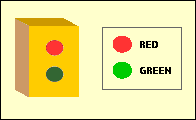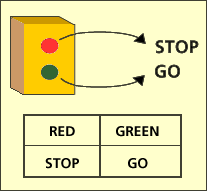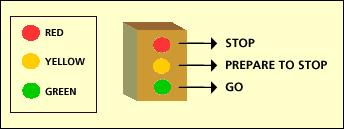
 TUTORIAL: Information
TUTORIAL: Information
INTRODUCTION .
DATA .
RULES .
CODES .
UNCERTAINTY .
CONTEXT
Information is in essence a theory about making the possible actual. It sets
an event which does happen in the context of other and different events which
only might have happened, so that potential and actual are related. Aristotle
talked about possibilities, but he also appreciated the importance of limits on
the number of possibilities imposed by the forms. A form constrains matter,
even while enabling it to realize its potential, and does not leave it free to
be anything and everything. --Jeremy Campbell
Imagine a box on the outside of which are two lights - one red and
one green. The following picture illustrates such a box.
 The goal of this exercise will be to construct a standard U.S. stoplight, but for the
moment, think of this as simply a box with two differently colored
lights. If each light can be either on or off (i.e.,
none will ever be "blinking"), then from this paradigm of two lights, it is possible to construct four syntagms:
The goal of this exercise will be to construct a standard U.S. stoplight, but for the
moment, think of this as simply a box with two differently colored
lights. If each light can be either on or off (i.e.,
none will ever be "blinking"), then from this paradigm of two lights, it is possible to construct four syntagms:
- both lights off
- both lights on
- red on and green off
- green on and red off
In this exercise, the last two of these will become the "traffic control" paradigm. To construct a traffic light, this paradigm must be matched to a
paradigm of two elements from the behaviors of the automobile driving public, in this case, "Stop" and "Go" The picture shows how a code of two rules would map the paradigms together.
To construct a traffic light, this paradigm must be matched to a
paradigm of two elements from the behaviors of the automobile driving public, in this case, "Stop" and "Go" The picture shows how a code of two rules would map the paradigms together.
This set of rules would produce patterns of traffic at the
intersection that is controlled by the light. Sometimes these patterns will
show a smooth flow of traffic; sometimes they will show long lines and
"backups."
Clearly, the light organizes the flow of traffic by imposing
constraints on the activities of the drivers of the cars. But, as you may have
noticed, this is not yet a depiction of a real traffic light; the yellow element is missing. The need for the yellow light illustrates the concept of
information.
 3008
3008
 3010
3010
If a city was to try the "Red/Green" light out on the streets, it would discover a problem. Some drivers coming up to an intersection during a
green light would suddenly be confronted with a change to red. If they were
moving fast enough, and were close enough to the intersection, these drivers
would not have time to stop. Yet, the drivers whose red light had just changed
to green would be able to go. The likely result would be collisions.
The problem, as it turns out, is that "stop" is not an instantaneous event. A
driver must begin to stop the car sometime prior to actually arriving at being
stopped.
In this situation, where the oncoming drivers would find themselves
uncertain as to when the green light would change to red, some might
proceed cautiously, and others might not, but none would be sure when the light
might change, everyone would be confused, and all would be taking a chance on
having a collision.
The purpose of the yellow light is to resolve this uncertainty by
informing the oncoming drivers that the light will soon change to red.
In other words, the yellow element of the traffic light paradigm maps on to the element of driving
behavior known as "prepare to stop the car".

 3009
3009
 3011
3011
 3012
3012
 3024
3024
Communication that reduces uncertainty in the receiver is said to informthe receiver.
As with communication itself, information is a process. It is important to
notice the difference between data, which are the patterns that human beings
perceive with their senses, and information, which is the process by which
human interpretation of those patterns reduces their uncertainty.  How do clocks inform?
How do clocks inform?
 1017.
1017.
 3013
3013
 3014
3014
 3015
3015
The relationship between data and meaning will be examined in
greater depth in the next section of this tutorial. But because it is so important, it must again be
emphasized that data is
that which is encountered by the senses, while information is the process by which
data are interpreted and uncertainty is reduced.
A claim of relevance is a claim that the message will combine with and alter
the context in some way, for example, by adding new facts or ideas or by
changing previously available ideas. Interpretation requires discovering the
relevance of a message and may include expanding or changing the interpreter's
understanding of what the context is. For example, the interpreter may have
thought the context of a conversation with an old acquaintance was "the good
old days," until a remark about "making sure your loved ones are provided for"
invokes the very different context of "selling life insurance." Once the new
context has been invoked, the relevance of previous parts of the conversation
may change in a radical way. For example, questions about one's career
development may be reinterpreted as an attempt to gauge the likely size of an
expected sales commission rather than as evidence of personal interest.
-- David Ritchie
The traffic light that was described in the previous section is a communication
device, but it is a very simple communication device. One of its
characteristics is that it always flashes the same lights, in the same
sequence, for the same amount of time...forever, if the power holds out. This
means that the light never adjusts to changes in the flow of traffic through
its intersection. On the other hand, a human police officer standing at the
same intersection would be able recognize changes in the traffic flow and
adjust the time allotted accordingly. This is an important property of human
consciousness, and its role in human communication is equally important.
 3025
3025
 3026
3026
Without uncertainty there can be no meaning. A receiver who has
complete certainty with respect to an incoming message would be able to
predict its contents with one-hundred-per-cent accuracy. But if a receiver is
absolutely sure what a message will say, then it cannot mean anything (because
the receiver already knows all about it).
In our earlier example, the traffic light is oblivious to information. It has
no uncertainty at all -- it simply follows its program and performs its
function. Because of this, it is completely out of touch with its environment,
and thus, it is unable to adjust to changing
situations.
On the other hand, human beings are in constant touch with their environments.
They are always somewhat uncertain, and they are always receiving data, much of
which is informative. We speak of this property of being "in touch" with
everything around us as having context.
Mechanical devices have little
context; consequently they have little uncertainty and they are unable to
receive very much in the way of meaningful communication. But human beings are extremely contextual; they are constantly
aware of what they know and don't know, and they constantly seek information
and meaningful communication.
 3027
3027
 3030
3030
 3031
3031
 3032
3032
- INTRODUCTION
"Information" is the name given to the various processess by which the reception of a message reduces uncertainty in the receiver.
- RULES
Rules are constraints that guide a process in producing a particular
pattern.
- UNCERTAINTY
Data is that which is encountered by the senses; information is the process by which data are interpreted and uncertainty is reduced.
The next unit in the tutorial is: SIGNS AND LANGUAGE

 The goal of this exercise will be to construct a standard U.S. stoplight, but for the
moment, think of this as simply a box with two differently colored
lights. If each light can be either on or off (i.e.,
none will ever be "blinking"), then from this paradigm of two lights, it is possible to construct four syntagms:
The goal of this exercise will be to construct a standard U.S. stoplight, but for the
moment, think of this as simply a box with two differently colored
lights. If each light can be either on or off (i.e.,
none will ever be "blinking"), then from this paradigm of two lights, it is possible to construct four syntagms:
 TUTORIAL: Information
TUTORIAL: Information To construct a traffic light, this paradigm must be matched to a
paradigm of two elements from the behaviors of the automobile driving public, in this case, "Stop" and "Go" The picture shows how a code of two rules would map the paradigms together.
To construct a traffic light, this paradigm must be matched to a
paradigm of two elements from the behaviors of the automobile driving public, in this case, "Stop" and "Go" The picture shows how a code of two rules would map the paradigms together.